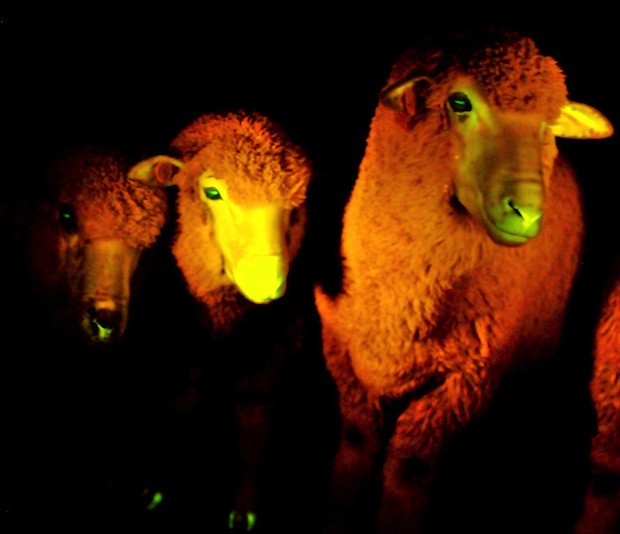Glow, glow black sheep


BUENOS AIRES -- They look like any other sheep by the light of day, but shine a ultraviolet light on them in the dark and suddenly they're fluorescent glow sticks dressed in sheep's clothing.
Engineered by a group of Uruguayan scientists from the Animal Reproduction Institute of Uruguay (IRAUy, for its initials in Spanish) and the Montevideo branch of the Paris-based Pasteur Institute (IPMon), these nine glowing green lambs are the first transgenic (genetically enhanced) sheep produced in Latin America.
The 13 scientists inserted a gene for Green Fluorescent Protein (GFP), a protein first found in the Aequorea victoria (or Crystal Jelly) jellyfish, into lab-fertilized sheep embryos which, in turn, were implanted into surrogate mothers. Five months later they were born, all aglow.
Sheep ranching is a big business in the rolling hills of Uruguay. The tiny country's human population of 3.4 million people is vastly outnumbered by some 7.5 million sheep (who, happily, have never united to overthrow the human overlords who shear and eat them). The creation of glowing sheep had nothing to do with making it easier for Uruguayan shepherds to find their flocks at night, however.
Rather, the use of GFP was a kind of proof of concept meant to verify that the relatively untested gene insertion technique would work in a sheep, says Dr. Alejo Menchaca (IRAUy), a biologist who, along with Dr. Martina Crispo (Pasteur), led the project. By glowing under UV-like blue light -- as they did -- the sheep proved that the technique had been a success.
In the long run, Menchaca says, the goal is to use this gene insertion technique to create sheep (and cows and goats) that produce human medicines in their milk.
"If, instead of using the GFP gene, we inserted the gene responsible for insulin production, the sheep, goat or cow could produce insulin in their milk," says Menchaca. "With a few transgenic cows, we could produce insulin for much of the population suffering from diabetes. This production is much cheaper than current techniques, and therefore it increases access for sick people. There is a long list of diseases whose cure or treatment could be improved, especially in poorer socioeconomic groups."
For now, it pays to glow. Their uniqueness and growing international fame will protect these nine sheep from the fate that befalls most of their Uruguayan compatriots. They will wander the country's grassy hillsides in peace, safe in the knowledge that no one will turn them into glowing sweaters or fluorescent roasts.
"They will live like queens, as they are not like any other sheep from the flock," says Menchaca. "In our country, sheep are usually raised for meat and wool, which means that at some point they are slaughtered for human consumption. This will not happen with our sheep, however. They can look forward to a long life in which they will be well cared for, have plenty of food, and live in a lovely place under the open sky."
Having such a long, full life begs the obvious question of what will happen if two glowing sheep come together to produce lambs: Would they also glow? When asked, Menchaca took a demure stance on their procreative future.
"It's possible," he says. "But that's not the interest of our study."
Photos from IRAUy and Sierra Blakely/Wikipedia.
This post was originally published on Smartplanet.com